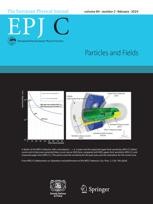Detecting solar neutrinos with the Borexino experiment
Neutrinos produced by the CNO cycle within the core of the Sun are being hunted by the Borexino experiment so that we may learn more about this important nuclear process.
New York | Heidelberg, 3 December 2020
 Neutrinos are chargeless particles with about a mass about a millionth that of an electron that are created by the nuclear processes that occur in the Sun and other stars. These particles are often colourfully described as the ‘ghosts’ of the particle zoo because they interact so weakly with matter. A paper published in EPJ C by the Borexino collaboration – including XueFeng Ding, Postdoc Associate of Physics at Princeton University, United States – documents the attempts of the Borexino experiment to measure low-energy neutrinos from the Sun’s carbon-nitrogen-oxygen (CNO) cycle for the first time.
Neutrinos are chargeless particles with about a mass about a millionth that of an electron that are created by the nuclear processes that occur in the Sun and other stars. These particles are often colourfully described as the ‘ghosts’ of the particle zoo because they interact so weakly with matter. A paper published in EPJ C by the Borexino collaboration – including XueFeng Ding, Postdoc Associate of Physics at Princeton University, United States – documents the attempts of the Borexino experiment to measure low-energy neutrinos from the Sun’s carbon-nitrogen-oxygen (CNO) cycle for the first time.
“This giant instrument, buried beneath the Gran Sasso mountains in the Gran Sasso National Laboratory in Italy, is capturing ghost-like neutrinos from a so-called CNO process in the very centre of the Sun,” Ding explains. “We made tens of thousands of simulations and predicted that we would be able to prove these ‘CNO’ ghosts exist for the first time in human history ever.”
The Sun produces energy by converting four hydrogen nuclei to one helium nucleus through two mechanisms. The majority of energy produced by the Sun is initiated by the direct fusion of two protons into a deuteron, starting the pp chain, the other mechanism is catalysed by heavier nuclei, such as carbon, nitrogen and oxygen, known as the CNO cycle – which produces about 1% of our star’s energy output. As well as this small energy contribution, the CNO cycle should also produce about 1% of the neutrinos that stream from the Sun.
“Neutrinos from the CNO cycle process in the Sun had remained essentially hypothetical until the recent report of Borexino on the Neutrino 2020 conference,” Ding says. “Borexino has been looking for CNO neutrinos since 2016 after the thermal insulation system and active temperature control system were installed. This paper reports a quantitative study on the Borexino sensitivity in searching for CNO neutrinos and explains the methodology.”
Since the Sun itself only has a 1% CNO branch, and since neutrinos are already incredibly difficult to detect, there has been essentially no measurement yet of the CNO process itself, even though it is believed to be the dominate energy production avenue in stars much more massive than the Sun. Detecting neutrinos from the CNO cycle will teach researchers much more about it, in turn revealing the secrets locked beneath the surface of the Universe’s most massive stars.
References: M. Agostini et al. (BOREXINO collaboration), (2020), Sensitivity to neutrinos from the solar CNO cycle in Borexino, European Physical Journal C 80:1091, DOI 10.1140/epjc/s10052-020-08534-2
Further Information
For more information visit: www.epj.org
Services for Journalists
The full-text article is available open access here.
Contact
Sabine Lehr | Springer | Physics Editorial Department
tel +49-6221-487-8336 | sabine.lehr@springer.com
